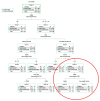Methodological Review of Classification Trees for Risk Stratification: An Application Example in the Obesity Paradox
- PMID: 40507172
- PMCID: PMC12157015
- DOI: 10.3390/nu17111903
Methodological Review of Classification Trees for Risk Stratification: An Application Example in the Obesity Paradox
Abstract
Background: Classification trees (CTs) are widely used machine learning algorithms with growing applications in clinical research, especially for risk stratification. Their ability to generate interpretable decision rules makes them attractive to healthcare professionals. This review provides an accessible yet rigorous overview of CT methodology for clinicians, highlighting their utility through a case study addressing the "obesity paradox" in critically ill patients.
Methods: We describe key methodological aspects of CTs, including model development, pruning, validation, and classification types (simple, ensemble, and hybrid). Using data from the ENPIC (Evaluation of Practical Nutrition Practices in the Critical Care Patient) study, which assessed artificial nutrition in ICU (intensive care unit) patients, we applied various CT approaches-CART (classification and regression trees), CHAID (chi-square automatic interaction detection), and XGBoost (extreme gradient boosting)-and compared them with logistic regression. SHAP (SHapley Additive exPlanation) values were used to interpret ensemble models.
Results: CTs allowed for identification of optimal cut-off points in continuous variables and revealed complex, non-linear interactions among predictors. Although the obesity paradox was not confirmed in the full cohort, CTs uncovered a specific subgroup in which obesity was associated with reduced mortality. The ensemble model (XGBoost) achieved the best predictive performance (highest area under the ROC curve), though at the expense of interpretability.
Conclusions: CTs are valuable tools in clinical epidemiology, complementing traditional models by uncovering hidden patterns and enhancing risk stratification. While ensemble models offer superior predictive accuracy, their complexity necessitates interpretability techniques such as SHAP. CT-based approaches can guide personalized medicine but require cautious interpretation and external validation.
Keywords: classification trees; intensive care unit; machine learning; obesity paradox; prediction modelling.
Conflict of interest statement
The authors declare no conflicts of interest.
Figures






References
-
- Quinlan J.R. Induction of decision trees. Mach. Learn. 1986;1:81–106. doi: 10.1007/BF00116251. - DOI
Publication types
MeSH terms
LinkOut - more resources
Full Text Sources
Medical
Research Materials

